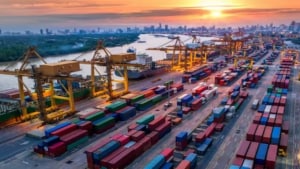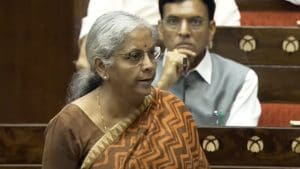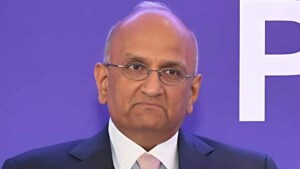Robust balancesheets and reforms to pave the way for India’s 7.5% GDP growth, says CII President

KV Prasad Jun 13, 2022, 06:35 AM IST (Published)
 Listen to the Article (6 Minutes)
Listen to the Article (6 Minutes)
Summary
President of Confederation of Indian Industry (CII) R Dinesh tells CNBC-TV18 that the government’s transformational reforms and the improved balance sheets of banks and companies will allow India to hit 7.5 percent GDP growth in FY24.
The Q4FY23 GDP data sprung a pleasant surprise taking the FY23 growth rate to 7.2 percent and with this several brokerages have upgraded their GDP forecast for FY24.
Economists too are pointing to several tailwinds for growth this fiscal. They believe capital expansion has started to take off and that corporate and bank balance sheets being in much better shape will allow some risk taking.
Meanwhile, the newly elected President of Confederation of Indian Industry (CII) R Dinesh also expects growth rate to hit 7.5 percent in FY24.
Speaking to exclusively to CNBC-TV18, Dinesh said the government’s transformational reforms and balance sheets of banks and companies being in better shape will allow India to hit 7.5 percent GDP growth in FY24.
He expects private sector capex to pick up as capacity utilisation across all sectors has crossed 75 percent.
Below are the excerpts from the interview.
Q: You are taking over at a time when things are looking good both at the macro front as well as at the micro front. What do you feel most confident about in terms of the tailwinds?
A: If I look at it from the economic perspective, the fact is that maybe India has really become the island of growth. More than 15 percent of the global economy’s growth is going to come from India.
Reasons for us being more than comfortable is the fact that we see good expenditure on the infrastructure leading to a virtuous cycle. That cycle is increasing domestic demand and that also attracts foreign investment to come in or Indian investment to happen and that again perpetuates a cycle of allowing opportunities to export which leads to good growth for all of us.
Second is, balance sheet of companies as well as the banks are much better than before. If you look at the various opportunities which are happening from the global economy, I think all of it is playing to our favour.
Also the way in which the government has done transformational reforms, I think that has attracted interest from all over the world. Where ever we have been meeting investors or potential investors into India, we have heard great interest in looking at this and that is what gives us the confidence that we can hit this rate of growth.
Q: Let us talk about interest rates. Ahead of the last policy, CII had put forward a request to the RBI MPC to decouple and pause and perhaps the RBI heard what you had to say, because there was a pause, it was a hawkish pause. But of course, the commentary suggests that things may change, I don’t want to preempt what the MPC is likely to do on the 8th of June. But what is the expectation on that front, as far as rates are concerned? Do you expect the pause to continue by when do you expect or hope that we could perhaps be ready for even cuts?
A: I think if you look at it, we are definitely saying that we want the pause to continue, but the stance to change from hawkish to neutral, and that is more helping the perception of what the future is going to be. I think the RBI governor, when we recently met was very clear in saying that he’s not the deciding person, but what happens at the ground level, especially with inflation, is going to be the important factor.
I think, from CII’s perspective, we do understand, and we believe that inflation has to be kept in check. And right now we see all the right signals coming not just from the market, but also from our survey which we did with our CEOs. Having said that, the target he has set for himself is 4.5 percent. And therefore, we have to wait and watch and see by October that it comes to that level or below that level, then we can look at a reduction in interest rates. Right now, for us, the focus is on making sure it’s a pause and changing the stance from hawkish to neutral.
Q: You spoke about opportunities and you spoke about business confidence. And in that context, I want to address the issue of private investment. The chief economic adviser at the CII meeting, which I was a part of did suggest that he believes things are going to pick up and accelerate further from here on. We’re already seeing signs of a pickup. But when you speak with your members today, what’s the indication that you get, when do you expect them to start adding fresh capacity? Are they looking at adding fresh capacity in this financial year? Which are the sectors where you believe we will see those industries take the lead in terms of adding capacity?
A: We have our annual CEO survey and what we are getting as feedback is that the capacity utilisation across all sectors has now crossed more than 75 percent, which is the first signal to say that investment is likely to happen.
In a few sectors, which are related to infrastructure like cement and steel and most importantly, sectors like machinery are we are seeing capacity utilisation exceeding 80 percent. Machinery is a very clear indicator, because they will be supplying to various other private sector players and that indicates that this is now hopefully coming across all sectors.
On the services side, if you look at it all of us know what’s happening at the hotel level, at the airlines level. So, all of it are all factors which we believe will mean that private sector capex will come back.
If I look at it from what we see as ground level reality as well, we see commitments having been made by the CMIE data, you actually see that those commitments are increased by 79 percent over the previous year, and if you look at the absolute number, we are speaking about close to Rs 25.7 lakh crore.
So, net net, if you look at it, it is a clear signal that private sector capex will happen and will continue to be committed for future growth.
Also Read: India’s manufacturing export showing green shoots, says CII president R Dinesh
Q: As the President of CII today, what is the to do list that you are presenting to the government to try and aid exports? We have, of course, seen a little bit of a bumpy road the last few months as far as exports are concerned on account of the global uncertainties. But we continue to be about 2 percent of global share at this point in time. So what’s on the to-do list on the export front? And again, in conversation with your members, where do you feel the most confident of in terms of new growth coming in from exports?
A:
A continued focus on services export is definitely there. But we see the green shoots in terms of the manufacturing exports as well going up. And like I mentioned, as overseas investment comes into India, they are coming in not just for the domestic demand, but obviously to look at export opportunities as well.
If you look at what needs to be done to further facilitate this, I think we have already looked at further fast tracking the FTAs, which the government is looking at bilaterally. And we believe that that presents a great opportunity for us to be able to further focus and grow our exports. Obviously, we spoke about having the National Trade & Promotion Board to be set up to further support this. And finally, like I said, the services side, the traditional sectors have done well. But other newer areas which we can focus on, include tourism as well.
Q: One of the concerns that has been flagged, is the growing regional inequities. We have seen that as being a legacy issue as well where the South has done much better in many parameters, including socio-economic parameters, but also in terms of economic growth. How as an industry body are you addressing this issue? Has there been any conversation and dialogue with state governments, with the central government on what can be done to ensure that we have much more equal distribution of growth?
A: That’s something which we continue to work with the states on. It’s not something which is going to happen overnight. There are two ways to look at this. One is, even within the states there could be some areas which are actually doing better and some areas where there is not that growth available. But all in all, if you look at today, I think there is a clear conscious awareness and the competitiveness has been built in amongst the states to make sure that they attract the right set of investors to come on board, whether it be manufacturing or other sectors to focus on. And as they pick and choose the sectors they want to play in, I think CII has been playing the lead role in supporting them and making sure that they are able to present themselves and orchestrate that availability, whether it be of the people capability or the people capacity as well as the land availability etc. if it comes to manufacturing.
One of the areas we spoke about was building a National Land Bank, which will also help underline where land is available across in plenty, which can attract more manufacturing investment to come in.
Q: Speaking of manufacturing investment, and you spoke about foreign investors looking at India, in the context of setting up manufacturing facilities. Given the diversification and de-risking of supply chains that we are starting to see, what are you hearing from SMEs? How are they hoping to leverage and capitalise on this opportunity? Again, which sectors do you believe within the manufacturing space are likely to be the biggest beneficiaries?
A: I think one of the core focus areas for CII has been on working with MSME members and the MSME sector in themselves. And within the MSME sector, I would call there are tier-I, tier-II, tier-III. And tier-III being what I would call livelihood businesses, which really do not look at return on capital employed, but actually look at the cash flow, which they generate, and as long as they have surplus cash flow available for their livelihood, they are happy to continue to exist.
I think it’s one of the primary responsibilities of CII to work with its members, because maybe 80-85 percent of SME sector, would be working with the large corporates as tier-I, tier-II suppliers. So the first is obviously to upgrade their capacity and capability to face what I would call as the new challenges which are going to come in from a manufacturing perspective, from digitisation perspective, as well as preparing for the future.
The second is the skill capacity augmentation. And that’s something CII has committed to work on to make happen as we go forward in this journey. And last, but not the least, is to prepare them, not just from the future aspect of it, but to make sure that they are able to coexist and grow as the sectors or as the new sectors come in. Where do we see this happening? I think it cuts across all manufacturing, obviously, services. I mean, if I look at even services like the new age services, like supply chain, etc, there are large opportunities for MSMEs to partner with and grow.
Q: 2024 is going to be the election year, so what’s the expectation? We have seen the government say that it continues to stand by its promise of privatisation. But with the exception of Air India, we haven’t really seen much take off, no pun intended. And on the other aspect, which is things like taxing the rich more, etc. What’s the expectation, there’s been a lot of talk around a capital gains tax overhaul, which was expected to happen in this budget, it didn’t go through. What’s the expectation on both these issues, as we head into an election year?
A: I think this government actually has walked the talk. I think they have stood by whatever they are committed to. And we have just seen the budget, which was just over which I would call as a dream budget from various aspects of it. Therefore, I think our expectation would be that this would continue, the necessary actions will be taken to support the longer term growth of the country and of the economy. I don’t think they are looking at any short term actions, which are either going to impact or affect any of this.
I think the second question with regards to, is there going to be any action on increased taxes, etc. My understanding is that this was the last budget of this government, and the next one would be a vote on account. So I don’t expect that there will be any major changes taking place, unless anything changes dramatically in the economy or the rest of the world. So for us, I would look at it as this government continues to stay the course, walk the talk in terms of infrastructure spend, do what has been committed in this budget, and we welcome that and we really look forward to that.
Also Read: India is likely to grow around 7.8% in the next decade: CII President
Q: So the single biggest priority for you as you now start your tenure at CII?
A: I think to make Indian industry more competitive. And I have already stated that from our side. We wish to work with various stakeholders in the society to build trust, and make sure that we are positively making an impact and we really don’t look for mandates from anybody else to create that stakeholder relationship and build the trust in our partnership.
Obviously growth is going to happen as we build the competitiveness of our industry and work with various sectors, starting from the large corporates all the way into the MSMEs and their livelihood businesses, and build trust as we do that.

Elon Musk forms several ‘X Holdings’ companies to fund potential Twitter buyout
3 Mins Read
Thursday’s filing dispelled some doubts, though Musk still has work to do. He and his advisers will spend the coming days vetting potential investors for the equity portion of his offer, according to people familiar with the matter

KV Prasad Journo follow politics, process in Parliament and US Congress. Former Congressional APSA-Fulbright Fellow










 Listen to the Article
Listen to the Article  Daily Newsletter
Daily Newsletter













